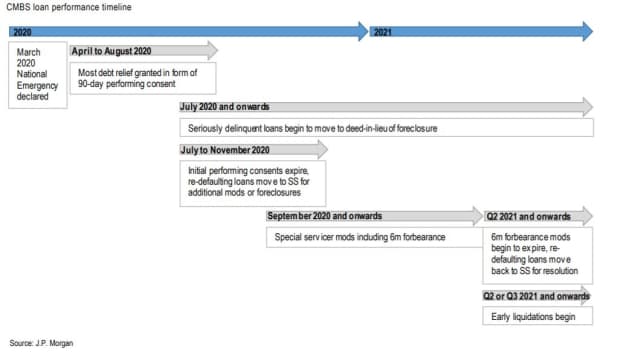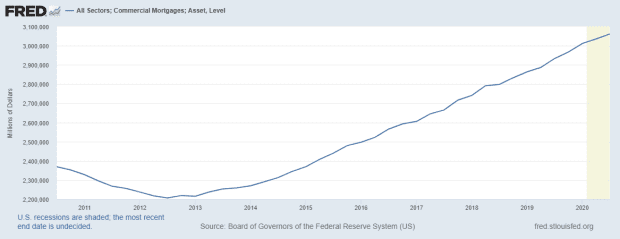Distress looms over U.S. commercial real estate in 2021
The world may remember 2020 as the year “normal life” was torn up by the coronavirus pandemic.
But for many U.S. commercial real estate owners the big trouble hasn’t even started yet.
“I think it’s going to be a two-headed monster,” said Pat Jackson, chief executive officer and founder of Sabal Capital Partners in Irvine, Calif., of the outlook for struggling commercial buildings.
“Some assets are going to recover and do well. Obviously, we’re very bullish on multifamily over the long-term,” said Jackson, a lender and investor in billions worth of battered assets in the last recession. “On the flip side, there’s a lot of distress and it’s coming.”
Jackson sees properties that have run “out of runway,” after almost a year of business disruptions. And while the government races to distribute vaccines, lockdowns in the U.S. have ramped back up in the colder months as COVID-19 cases, hospitalizations and deaths soared.
The resurgence of the coronavirus has stoked fears that a V-shaped economic recovery could be out of reach, while also spurring concern that banking regulators, worried about potentially spiraling risks to the financial system, might crack down on banks and others exposed to souring real estate.
“The second surge of COVID hasn’t helped anyone,” said Lisa Pendergast, executive director at the CRE Finance Council, a commercial real estate finance trade group.
Pendergast pointed to the 10.2% of loans out of the near $600 billion commercial mortgage-backed securities (CMBS) market that in November were in “special servicing,” a category that is often the first stop for borrowers looking for temporary or permanent debt relief.
That’s below the 12.6% peak in the wake of the 2008 global financial crisis, which took about two years to reach. But the volume of problem loans easily could grow as the pandemic wears on and more borrowers come to grips with its fallout, including how the use of commercial buildings ends up changing.
In a sign of the times, New York City’s reeling commercial real-estate industry recently put forth a proposal to turn some 1 million square feet of Manhattan office space into housing, the New York Times reported, an effort to avert a potential collapse in property prices.
Check out: Ho, ho — oh, no! Values of troubled Manhattan retail properties sink 53%.
Big property owners also have become a key focal point, because unlike real-estate loans held by banks and insurance companies, the CMBS market makes it fairly easy for borrowers on Wall Street to walk away from properties when trouble hits.
“You can just hand back the keys,” Pendergast said of most CMBS financing.
A road map for distress
For decades, the CMBS market has been a key corner of finance where loans on hotels, offices, industrial centers and other commercial properties are packaged into bond deals and sold to investors, including pension and bond funds.
While it isn’t the largest source of commercial real estate finance, CMBS appeals to borrowers looking for debt on a non-recourse basis, meaning if a property fails or ends up underwater, a lender can’t go after the operator’s other assets to recoup losses.
“Keep in mind,” Pendergast said, “A lot of borrowers, if they secured an asset five, six or seven years ago, they probably made a good return on their equity and made a profit.” Some will say, “Take my asset.”
Read: Simon Property gives up on four struggling malls. Why more could follow
Rarely has that been the case this year. Distressed sales accounted for only about 1% of all commercial property sales in the past two quarters, according to Real Capital Analytics, even though more likely will come.
Analysts led by John Sim at J.P. Morgan put together this potential timeline for CMBS loans and distress, including key dates when relief programs expire, after a deluge of property owners fell behind in March when a national emergency was declared.

Properties to watch
While it may be easier for CMBS borrowers to walk away from their debts, high profile problems don’t often go away quietly.
That’s because bondholders receive monthly property-level performance reports that make it possible to track specific struggling malls, iconic hotels and even the decline of a historic Times Square building financed by President Trump’s son-in-law in the months before he took office.
Jared Kushner cosigned loans to financed 229 West 43rd Street, an 18-property that onced house the New York Times, in October 2016, before he became a White House adviser to his father-in-law.
It’s among about $1.1 billion worth of property loans now considered distressed in Times Square, according to real-estate data tracking platform CREDiQ. And its latest property appraisal slashed its value by 80% to about $92.5 million.
“That was kind of an eye-opener to see how much the value had dropped,” said CREDiQ co-founder Bill Petersen. But he also thinks the property’s woes may not necessarily end up reflecting the value of other Times Square buildings, given that it lost major tenants even before the pandemic hit.
Kushner Properties did not respond to a request for comment.
Record CRE debt
Ryan Severino, chief economist at commercial real-estate firm JLL JLL,
But Severino also sees an uphill battle for properties that struggled before COVID-19 hit, or in his words, buildings that “after 10-plus years of economic expansion” failed to find a footing, including lower-quality malls and office buildings in less desirable areas, which have languished since the last recession.
The overall stakes have never been higher. Federal Reserve data shows U.S. commercial property debt climbed to an all-time high of $3.06 trillion in the third quarter, from a 10-year low of $2.2 trillion in 2012.

CRE debt hits record
St. Louis Fed data
Some property debt will be repaid without a hitch. Other owners will find debt or equity to ride out the storm.
But the pandemic still likely means some properties will fetch fire sale prices. At least, that’s the hope among bargain hunters.
“It’s really good when everyone is looking for opportunities,” said Gayle Klein, a principal at law firm McKool Smith, who represents hedge funds, private equity and others in commercial and securities litigation. “Because my clients do have money to spend.”



